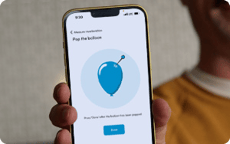15 ways to spark student reflection in your college classroom

Posted by Tricia Whenham on Apr 9, 2020 8:34:00 AM
A research study led by professors at Harvard Business School confirmed what many higher ed faculty members know already — reflection matters. The professors conducted three different experiments (with university students and people in the workplace), and the results were consistent. Simply asking test subjects to take a few minutes to reflect resulted in better performance over time — improvements of up to 25%.
Reflection can feel like just one more thing to cram into an already too-short course. But stopping to take a breath rather than jumping right to the next project or activity helps students learn from mistakes and recognize strengths and weaknesses. It can make the difference between success and failure, in school and beyond. And it can be done well whether students are in the classroom, online or both.
Are you looking for some new ways to increase student reflection in your college or university classroom? Here are 15 ideas you can try tomorrow.
1. Write the one-minute paper
How much could you explain in one minute? At the end of class, set a timer and ask students to record their most eye-opening revelations or biggest questions. This activity lets students reflect on learning and build writing skills — plus you’ll get a window into their understandings and misunderstandings. Here are some prompts you can use to get students writing.
2. Sketch reflections
Have you discovered sketchnotes? It’s a visual note-taking style that mixes writing, drawing and other visual cues. And it’s not about the quality of the art — it’s about how a different medium prompts students to look at learning from a different perspective. Sketchnoting is often used for lecture notes, but it’s just as effective when students need to reflect.
3. Create reflection snowballs
If you need to liven up a quiet class, this activity is for you. After a mini lecture or presentation, each of your students writes a key reflection on a sheet of paper and crumples it up. Then all the students toss their papers to the other side of the room. Once students catch a “snowball,” they read it, add something new and repeat. If some or all of your students are remote, use randomized breakout rooms in your conferencing software to get students to pair up and share their reflections. Here’s how breakout rooms work in Zoom.
4. Develop a professional portfolio
Portfolio building is a mainstay of arts programs, where students need concrete ways to demonstrate the breadth of their knowledge and experience. But the act of choosing one’s best work — and articulating why — can increase reflection in many schools of study.
5. Use dedicated reflection journals
Journaling is a tried-and-true reflection activity — especially for practicum-based programs like nursing and education where it’s crucial that students connect theory to reality. But there may be some options you’re not aware of (ever used key phrase journals? Double-entry journals?). Here’s a rundown of some ideas to try.
6. Get students blogging
If you’d like to take reflection into the cloud, blogs can be an excellent way to give student writing more value. And it’s simple to bring in links, images, videos and more. For a peek into how one university uses blogging to enhance student learning, check out Vanderbilt University’s resource page.
7. Take videos
To give your students a fresh perspective on their presentations, performances or practical skill development, pull out a phone and record them. Watching the videos can give them (and you) incredible insights into their progress. If your students are learning from home, they can record themselves with their phones and then post the videos to a shared class platform. Or you can record them during Zoom meetings and then share.
8. Write exit slips
Before students leave your class, ask them to quickly jot down what they’ve learned on a sticky note (or answer another reflection question). In hybrid classes, go digital and have them add the ideas to an online whiteboard or other shared collaborative space.
9. Capture quotable learning highlights
Sometimes, reflection comes from teasing out the ties between coursework and “real life.” Ask students to choose a famous quote and explain why it connects to a concept from class. They could also choose a song, a piece of art, a brand — anything that gets them thinking deeper and reveals a bit more about their passions and interests.
10. Take reflection breaks
Reflection can’t be forced, but it is a habit that can be instilled. Build reflective practice by stopping work periodically and encouraging students to record their thoughts about what they’ve learned. You can boost the reflection by having students share their thoughts with a peer — in person or in a videoconferencing breakout room. Eventually, students will start to reflect on their own, without your direction.
11. Add regular sprint retrospectives
Take a page from the agile process (not just for software developers anymore) and introduce sprint retrospectives. Every few weeks, you can set aside time to encourage students to reflect on where they’ve been and where they’re going. This is especially useful in helping student project teams avoid the usual pains of group work.
12. Try reflecting out loud
Reflection doesn’t have to be purely solitary. Sometimes, big insights come when students have the chance to share their reflections with a larger group. That’s why active learning classrooms should be easy to reconfigure for different activities, giving opportunities for both quiet reflection and group sharing. If some students are in the classroom and some are connecting from home, this can be tricky — make sure you choose audio conferencing tools that pick up all voices during classroom discussion. (Here’s how Nureva can help.)
13. Incorporate revision into assessment
Some of the best opportunities for reflection occur during the assessment process. Rather than having students submit work for a grade and then promptly forget about it, try giving them descriptive feedback instead and let them resubmit until they achieve mastery.
14. Prototype and test
Take inspiration from design thinking and create more meaningful opportunities for reflection. The end stages of the process — prototyping and testing — are particularly helpful. Design thinking is often associated with creating something concrete, like an app, but any project could benefit from a design-focused lens.
15. Model your own reflection
Actions speak louder than words. So be sure to model the same reflection skills you teach. Don’t be quiet about it either — talk out loud through your thought process to show students that reflecting doesn’t stop in the undergrad years.
What are you doing in your courses to get students reflecting?
Editor’s note: This post was originally published October 2015 and has been updated.

Posted by
Tricia Whenham
April 9, 2020

















